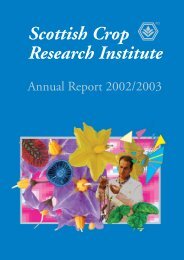SCRI Annual Report 2003/2004 - Scottish Crop Research Institute
SCRI Annual Report 2003/2004 - Scottish Crop Research Institute
SCRI Annual Report 2003/2004 - Scottish Crop Research Institute
Create successful ePaper yourself
Turn your PDF publications into a flip-book with our unique Google optimized e-Paper software.
Mechanisms & Processes<br />
fusion libraries, and have already identified valuable<br />
novel markers for subcellular components.<br />
The major thrust of the cell biology research is to<br />
understand the structure and function of plasmodesmata<br />
– channels connecting plant cells through which<br />
molecules and macromolecular complexes (including<br />
viruses) pass from cell to cell. Plasmodesmata have<br />
proven exceedingly difficult to analyse biochemically.<br />
A localisation screen, similar to that described above,<br />
successfully identified around a dozen potential plasmodesmatal<br />
candidate proteins which are currently<br />
being analysed.<br />
The acquisition of a new, state-of-the-art, confocal<br />
microscope has greatly increased the ability to exploit<br />
novel fluorescent proteins, while advanced techniques<br />
such as photoactivation, photoconversion, FlAsH,<br />
FRAP and FRET have facilitated studies of protein<br />
dynamics. Petra Boevink (CCC) has used the photoactivation<br />
of a recently developed GFP derivative for<br />
real-time analysis of protein movement between cells<br />
(see following article by Boevink, P. et al.).<br />
Fluorescence resonance energy transfer (FRET), a<br />
powerful but difficult technique to examine proteinprotein<br />
interactions in vivo, will be used to extend the<br />
research into the Golgi matrix proteins identified by<br />
Maita Latijnhouwers (CCC) in a highly successful collaborative<br />
project between <strong>SCRI</strong> and Oxford Brookes<br />
University (see following article by Latijnhouwers, M.<br />
et al.). In addition to the trafficking of various cellular<br />
molecules, a major question is how viral components<br />
target and modify plasmodesmata to facilitate virus<br />
movement. A detailed study of the Tobacco mosaic<br />
virus movement protein (TMV MP) by Kath Wright<br />
and colleagues in CCC used a selection of fluorescent<br />
markers for co-expression, photoactivation and fluorescence<br />
recovery after photobleaching (FRAP) to extend<br />
previous research that indicated that the TMV MP did<br />
not use microtubules to target the plasmodesmata, and<br />
to develop a new model for TMV movement. This<br />
work indicates that the TMV MP uses the endoplasmic<br />
reticulum to locate plasmodesmata and depends<br />
on the actin/myosin system for movement. Similarly,<br />
Tomas Canto and Peter Palukaitis (GE) identified<br />
sequences important for the CMV 3a movement protein<br />
to localise to plasmodesmata and showed that the<br />
3a protein also did not associate with microtubules as<br />
thought previously.<br />
The combination of cell biology and molecular pathology<br />
has revealed for the first time the association of the<br />
plant endocytic pathway in intercellular movement.<br />
Movement proteins encoded by the Potato mop-top<br />
virus were tagged with fluorescent markers and monitored<br />
in living cells, and found to associate with components<br />
of the secretory and endocytic pathways. In<br />
addition, protein interaction analysis revealed that one<br />
of the virus proteins (TGB2) interacted with a tobacco<br />
protein belonging to the highly conserved RME-8<br />
family of J-domain chaperones that are essential for<br />
endocytic trafficking in Caenorhabditis elegans and<br />
Drosophila melanogaster (see following article by<br />
Haupt, S. et al.).<br />
Scientists from all three programmes are involved in<br />
the application of their research to discovering new<br />
ways of controlling plant pests and pathogens. For<br />
example, John Jones (PPI) and colleagues from GE are<br />
developing novel strategies for control of potato nematodes<br />
bringing together expertise in molecular plant<br />
pathology and RNA metabolism within the theme.<br />
Similarly, Hugh Barker (GE) has been developing<br />
novel GM routes for controlling viruses via gene<br />
silencing. Several approaches have been tested to<br />
explore the possibility of designing transformation<br />
methods that confer resistance to multiple viruses<br />
through a single transgene.<br />
In addition to the successes of research groups in the<br />
theme and programmes, there have been notable individual<br />
achievements. Karl Oparka, the Programme<br />
Leader of CCC received the accolade of being made a<br />
Fellow of the Royal Society of Edinburgh and was also<br />
appointed to Honorary and Visiting Professorships at<br />
the University of Dundee and the Oxford Brookes<br />
University respectively. Sanjeev Kumar Sharma, a PhD<br />
student in GE won three prizes in the last year to<br />
attend an international meeting in San Francisco and<br />
for outstanding poster presentations. Finally, Steve<br />
Whisson (PPI) was awarded the Peter Massalski prize.<br />
The synergy obtained from combining molecular and<br />
cell biology, biochemistry and bioinformatics and the<br />
collaborations developed among scientists with wideranging<br />
expertise and knowledge provide the basis for<br />
understanding in detail the gene function of plants and<br />
pathogens. The knowledge generated at the molecular<br />
and cellular levels is essential to understanding processes<br />
of growth and development, and the plant’s<br />
response to environmental and pathogenic challenges,<br />
and more importantly to the development of innovative<br />
and original ideas and strategies for exploitation.<br />
The quality of science and potential for application is<br />
demonstrated by the high impact publications and the<br />
success in attracting external income and will be<br />
increasingly important for the future.<br />
118
















